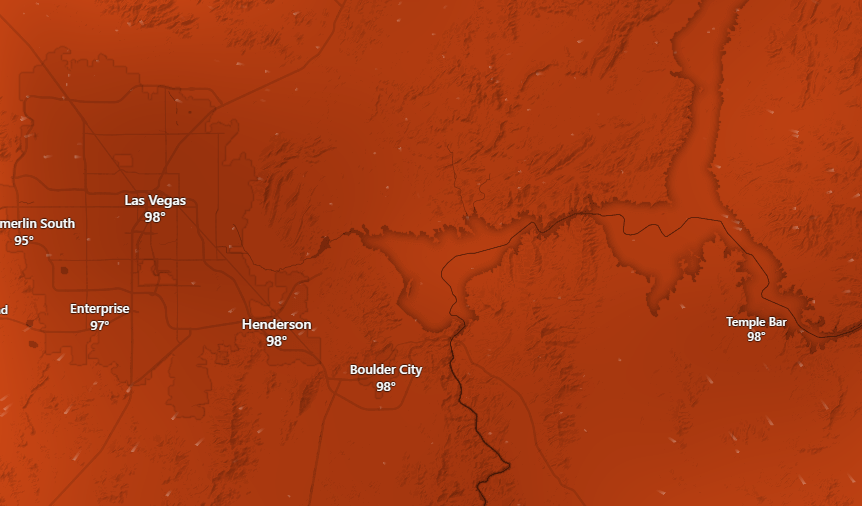The National Weather Service (NWS) issued an extreme heat warning effective from June 8 at 12:46 p.m. PDT until June 10 at 10 p.m. PDT, covering Lake Mead National Recreation Area, Death Valley National Park, and surrounding regions.
Temperatures were forecast to reach highs between 105 and 115 degrees in many areas, with Furnace Creek in Death Valley expected to approach 120 degrees. The announcement came as dangerous heat conditions swept through a large portion of Southern Nevada and adjacent areas.
Interactive maps from Windy.com showed the affected areas.
Why It Matters
This latest warning highlighted increasing risks of heat-related illnesses and fatalities amid early June’s soaring temperatures. For many Americans—especially in Las Vegas, Lake Mead, and other rapidly urbanizing desert locations—excessive heat intensifies public health threats and challenges infrastructure, including water management and recreation safety. Extreme heat events are becoming more frequent and severe, raising broader concerns about climate resilience in the Southwest.
What To Know
Record Temperatures and Broad Impact
The NWS reported that Las Vegas, Pahrump, and Barstow were expected to reach between 105 and 110 degrees, while Mesquite and areas near Lake Mead should anticipate 110 to 115 degrees. Furnace Creek in Death Valley was forecast to approach 120 degrees. The alert covered the Lake Mead National Recreation Area, Death Valley National Park, Western Mojave Desert, Northeast Clark County, Western Clark and Southern Nye County, and the Las Vegas Valley.
Health Risks and Safety Guidance
Extremely high temperatures can significantly increase the risk of heat exhaustion, heat stroke, and other serious health conditions. The NWS warned that “car interiors will reach lethal temperatures in a matter of minutes,” and instructed residents to drink fluids, stay in air-conditioned spaces, check on relatives and neighbors, and avoid leaving children or pets in vehicles.
Changes and Closures in Lake Mead Area
The National Park Service instituted seasonal trail closures through late September or early October for strenuous hikes in the Lake Mead National Recreation Area. Affected trails include Goldstrike Canyon, White Rock Canyon, Arizona Hot Springs, Liberty Arch, Lone Palm, and Sugar Loaf, due to safety risks posed by sustained high temperatures. Some hot springs remain accessible by boat and less strenuous trails remain open.
Water Levels and Other Environmental Concerns
The Lake Mead National Recreation Area has also faced declining water levels due to climate change and drought. Officials warned that launching and recovering watercraft may be more difficult, with some ramps requiring special attention and possible temporary closures.
Vulnerable Populations at Higher Risk
Elderly individuals, children, outdoor workers, and those with health conditions faced a heightened risk during the heat wave. Authorities urged the public to monitor updates and adhere strictly to safety instructions issued during this period.
What Happens Next
The extreme heat warning remained active until 10 p.m. PDT on June 10, 2025. The NWS advised residents and visitors to monitor official advisories for updates, while park officials continued to assess safety measures and trail closures as temperatures evolved.
Read the full article here
